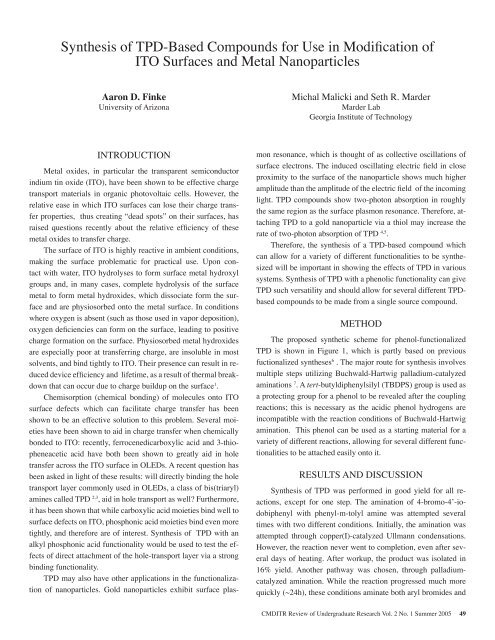Student Project Abstracts 2005 - Pluto - University of Washington
Student Project Abstracts 2005 - Pluto - University of Washington
Student Project Abstracts 2005 - Pluto - University of Washington
You also want an ePaper? Increase the reach of your titles
YUMPU automatically turns print PDFs into web optimized ePapers that Google loves.
Synthesis <strong>of</strong> TPD-Based Compounds for Use in Modification <strong>of</strong>ITO Surfaces and Metal NanoparticlesAaron D. Finke<strong>University</strong> <strong>of</strong> ArizonaMichal Malicki and Seth R. MarderMarder LabGeorgia Institute <strong>of</strong> TechnologyINTRODUCTIONMetal oxides, in particular the transparent semiconductorindium tin oxide (ITO), have been shown to be effective chargetransport materials in organic photovoltaic cells. However, therelative ease in which ITO surfaces can lose their charge transferproperties, thus creating “dead spots” on their surfaces, hasraised questions recently about the relative efficiency <strong>of</strong> thesemetal oxides to transfer charge.The surface <strong>of</strong> ITO is highly reactive in ambient conditions,making the surface problematic for practical use. Upon contactwith water, ITO hydrolyses to form surface metal hydroxylgroups and, in many cases, complete hydrolysis <strong>of</strong> the surfacemetal to form metal hydroxides, which dissociate form the surfaceand are physiosorbed onto the metal surface. In conditionswhere oxygen is absent (such as those used in vapor deposition),oxygen deficiencies can form on the surface, leading to positivecharge formation on the surface. Physiosorbed metal hydroxidesare especially poor at transferring charge, are insoluble in mostsolvents, and bind tightly to ITO. Their presence can result in reduceddevice efficiency and lifetime, as a result <strong>of</strong> thermal breakdownthat can occur due to charge buildup on the surface 1 .Chemisorption (chemical bonding) <strong>of</strong> molecules onto ITOsurface defects which can facilitate charge transfer has beenshown to be an effective solution to this problem. Several moietieshave been shown to aid in charge transfer when chemicallybonded to ITO: recently, ferrocenedicarboxylic acid and 3-thiopheneaceticacid have both been shown to greatly aid in holetransfer across the ITO surface in OLEDs. A recent question hasbeen asked in light <strong>of</strong> these results: will directly binding the holetransport layer commonly used in OLEDs, a class <strong>of</strong> bis(triaryl)amines called TPD 2,3 , aid in hole transport as well? Furthermore,it has been shown that while carboxylic acid moieties bind well tosurface defects on ITO, phosphonic acid moieties bind even moretightly, and therefore are <strong>of</strong> interest. Synthesis <strong>of</strong> TPD with analkyl phosphonic acid functionality would be used to test the effects<strong>of</strong> direct attachment <strong>of</strong> the hole-transport layer via a strongbinding functionality.TPD may also have other applications in the functionalization<strong>of</strong> nanoparticles. Gold nanoparticles exhibit surface plasmonresonance, which is thought <strong>of</strong> as collective oscillations <strong>of</strong>surface electrons. The induced oscillating electric field in closeproximity to the surface <strong>of</strong> the nanoparticle shows much higheramplitude than the amplitude <strong>of</strong> the electric field <strong>of</strong> the incominglight. TPD compounds show two-photon absorption in roughlythe same region as the surface plasmon resonance. Therefore, attachingTPD to a gold nanoparticle via a thiol may increase therate <strong>of</strong> two-photon absorption <strong>of</strong> TPD 4,5 .Therefore, the synthesis <strong>of</strong> a TPD-based compound whichcan allow for a variety <strong>of</strong> different functionalities to be synthesizedwill be important in showing the effects <strong>of</strong> TPD in varioussystems. Synthesis <strong>of</strong> TPD with a phenolic functionality can giveTPD such versatility and should allow for several different TPDbasedcompounds to be made from a single source compound.METHODThe proposed synthetic scheme for phenol-functionalizedTPD is shown in Figure 1, which is partly based on previousfuctionalized syntheses 6 . The major route for synthesis involvesmultiple steps utilizing Buchwald-Hartwig palladium-catalyzedaminations 7 . A tert-butyldiphenylsilyl (TBDPS) group is used asa protecting group for a phenol to be revealed after the couplingreactions; this is necessary as the acidic phenol hydrogens areincompatible with the reaction conditions <strong>of</strong> Buchwald-Hartwigamination. This phenol can be used as a starting material for avariety <strong>of</strong> different reactions, allowing for several different functionalitiesto be attached easily onto it.RESULTS AND DISCUSSIONSynthesis <strong>of</strong> TPD was performed in good yield for all reactions,except for one step. The amination <strong>of</strong> 4-bromo-4’-iodobiphenylwith phenyl-m-tolyl amine was attempted severaltimes with two different conditions. Initially, the amination wasattempted through copper(I)-catalyzed Ullmann condensations.However, the reaction never went to completion, even after severaldays <strong>of</strong> heating. After workup, the product was isolated in16% yield. Another pathway was chosen, through palladiumcatalyzedamination. While the reaction progressed much morequickly (~24h), these conditions aminate both aryl bromides andCMDITR Review <strong>of</strong> Undergraduate Research Vol. 2 No. 1 Summer <strong>2005</strong> 49




